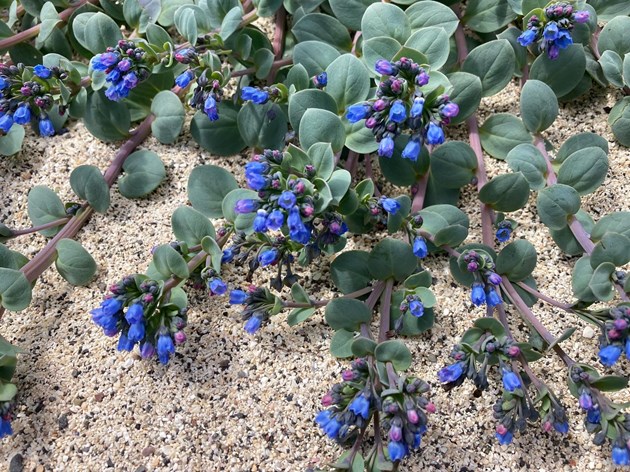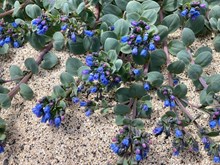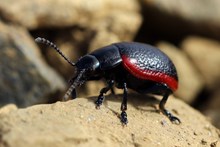26 May, 2023
Species on the Edge partnership news release: New multi-species conservation programme has arrived in Orkney

New multi-species conservation programme, Species on the Edge, has begun its four-and-a-half-year programme of conservation activity in Orkney.
Species on the Edge is a new bold and ambitious partnership programme of eight conservation charities, all dedicated to improving the fortunes of 37 priority species found along Scotland's coast and islands. Two Species on the Edge project officers will be based in Orkney for the duration of the four-and-a-half-year programme, working closely with local communities to help them support their local species.
Scotland’s coast and islands are amongst the most biodiverse areas in the UK. They provide a last refuge for some of our most beautiful and unusual, but also most vulnerable, species. Sadly, many of our species are now in decline and some are on the cusp of extinction. Species are facing threats from habitat loss, climate change, and changes of land use and land management. Human activities have contributed to the decline of some species, but people are also at the heart of reversing the rate of biodiversity decline.
With over £6 million of funding, including £4 million from the National Lottery Heritage Fund, together the eight Species on the Edge partner organisations will work with local communities to tackle the impacts of environmental change on wildlife, to benefit both nature and people. The partnership consists of Amphibian and Reptile Conservation, The Bat Conservation Trust, Buglife, Bumblebee Conservation Trust, Butterfly Conservation, NatureScot, Plantlife, and RSPB Scotland.
For the duration of the programme, Species on the Edge will be working across seven coastal and island areas in Scotland: Shetland; North Coast; East Coast; Solway; the Inner Hebrides and Argyll; the Outer Hebrides; and Orkney.
The Species on the Edge Orkney area team will be working to safeguard nine Orkney species: Arctic tern (Sterna paradisaea); common pipistrelle (Pipistrellus pipistrellus); curlew (Numenius arquata); great yellow bumblebee (Bombus distinguendus); lapwing (Vanellus vanellus); little tern (Sternula albifrons); oysterplant (Mertensia maritima); plantain leaf beetle (Chrysolina latecincta ssp. Intermedia); and Scottish primrose (Primula scotica).
Species on the Edge activity has kicked off in Orkney. Last week the Species on the Edge Orkney team took part in the Orkney Nature Festival, leading two wild walks on the isle of Shapinsay and at the Ring of Brodgar. During these walks, three of the nine Orkney Species on the Edge target species were spotted - curlew, lapwing, Arctic tern – as well as a white-tailed sea eagle and some seals.
Over the past month, the team have also spotted another four of the area’s nine target species – Scottish primrose, little tern, sea plantain leaf beetle and a common pipistrelle bat.
Working with local communities is a key part of the Species on the Edge programme and the teams based in each of the seven project areas will be working closely with those who live there to help them protect their local biodiversity. The programme will be offering opportunities to gain new skills and knowledge through workshops, training and volunteering. There will also be internships and work experience opportunities.
Graeme Walker, from Orkney Field Club, said "The practical help and public engagement which Species on the Edge is bringing to Orkney is very much welcomed by the Field Club. Some of our most vulnerable species, a list which includes plants, insects, birds and mammals, will benefit from the monitoring and habitat management of this timely project. Orkney Field Club members have already been out with the Species on the Edge team surveying for, and finding, the rare Plantain Leaf Beetle and we all look forward to further opportunities to be involved."
Alistair Whyte, Head of Plantlife Scotland, said: “Recent surveys have shown just how vulnerable some of our rare plant populations are. Species such as Oysterplant, and also Scottish Primrose, which is found in Orkney, Caithness, Sutherland, and nowhere else in the world, are a key feature of the Species on the Edge programme. We’ll be working with local communities to help safeguard these species. Species on the Edge offers an exciting chance for people to get involved in saving some of Scotland’s rarest species.”
In addition to leading events for the Orkney Nature Festival, the Orkney Species on the Edge team have already been working in local schools and they have been meeting members of the Orkney Field Club including local beetle enthusiast Alastair Forsyth.
Alastair Forsyth said: “There are more than 4,000 species of beetle in the UK and Ireland which play a very important role in the ecology of these islands, mostly in one or more of three ways: by feeding directly on plants and fungi, breaking down animal and plant debris or by predating other small creatures. Beetles are a key element of nearly all ecosystems.
One of our ‘species on the edge’ is the Sea Plantain Leaf Beetle Chrysolina intermedia which is known only from three places in the UK, all in Scotland. In Orkney this beetle is found in one small coastal area and despite extensive searching it has not been found elsewhere. It is an enigmatic, colourful species, rather ladybird-like, but very little is known about its biology. It’s great that Species on the Edge is engaged in discovering more about its requirements to ensure its future survival.”
Species on the Edge are currently part of the Stromness Museum summer exhibition ‘Nature in a Changing World’ where you can see a video of the Sea Plantain Leaf Beetle Chrysolina intermedia as well as a hundred-year-old Scottish primrose (Primula scotica) specimen from the museum collection. There will be a chance to hear more about Species on the Edge in Orkney at an evening talk at Stromness Musuem on Wednesday 14th June at 7.30pm. This talk is free but spaces are limited, so to book a place please contact Stromness Museum by email custodian@stromnessmuseum.org.uk or call 01856-850025.
Project activities in Orkney will include species survey and monitoring, habitat creation and restoration, education and learning events, farm demonstration events, signage and interpretation, advice for land managers, small-scale capital works, volunteering opportunities, training workshops, traineeships and work experience.
People of all ages will play a crucial role in all stages of the Species on the Edge programme; as champions and advocates, citizen scientists, practical conservation volunteers, and more. The Orkney Species on the Edge team would love to hear from anyone interested in getting involved and can be contacted at the RSPB office in Stromness by calling 01856 850176 or by emailing Sam Stringer (People Engagement Officer) Samantha.Stringer@rspb.org.uk or Helen Cromarty (Project Officer) Helen.Cromarty@rspb.org.uk.
To keep up to date with the Species on the Edge programme across Scotland, go to the website: https://www.nature.scot/scotlands-biodiversity/species-edge-sote/species-edge-about-project and follow along on Twitter (@SpeciesEdge) and on Facebook (@SpeciesontheEdge).
All volunteering opportunities will also be shared under Species on the Edge Orkney titles here:
https://volunteer.rspb.org.uk/opportunities#display=grid&s=date_advertised&o=desc
Contact information
- Name
- NatureScot Media
- Telephone
- 0131 316 2655
- media@nature.scot
Notes to editors
The Amphibian and Reptile Conservation Trust (ARC) is a national wildlife charity focusing on toads, frogs, newts, snakes, lizards and marine turtles. ARC conserves amphibians and reptiles, and the habitats on which they depend, to protect them for future generations. The Trust runs species recovery programmes, monitoring, scientific research, advocacy, outreach and regional projects. ARC owns 24 nature reserves and manages 80, covering 1,900 hectares, and works with a wide range of partner organisations, volunteers and specialists. ARC continues a 50-year history of reptile and amphibian conservation. The charity was established in June 2009 by the Herpetological Conservation Trust (HCT), which was formed in 1989. HCT grew out of the British Herpetological Society’s Conservation Committee, formed in 1969. For more information visit www.arc-trust.org
The Bat Conservation Trust is the leading non-governmental organisation in the United Kingdom solely devoted to the conservation of bats and the landscapes on which they rely. The breadth and depth of our work is driven by our vision of a world rich in wildlife where bats and people thrive together. Through monitoring and direct conservation action we can secure the future of our bat species in Scotland.
Buglife - The Invertebrate Conservation Trust is the only charity in Europe devoted to the conservation of all invertebrates. Our aim is to halt the extinction of invertebrate species and to achieve sustainable populations of invertebrates across the UK. We are working hard to achieve this through: Undertaking practical conservation projects that will contribute to achieving our aim. Promoting the environmental importance of invertebrates and raising awareness about the challenges to their survival. Assisting in the development of legislation and policy that will ensure the conservation of invertebrates. Developing and disseminating knowledge about how to conserve invertebrates. Encouraging and supporting invertebrate conservation initiatives by other organisations in the UK, Europe and worldwide.
Further information is available on Buglife’s website at www.buglife.org.uk, follow us on Twitter: @BuglifeScotland and ‘Like us’ on Facebook: Buglife – The Invertebrate Conservation Trust.
The Bumblebee Conservation Trust is a membership charity that was established in 2006 due to serious concerns about the ‘plight of the bumblebee’. In the last 80 years many bumblebee populations have crashed and two species have become extinct in the UK. The Trust carries out science, conservation, and people engagement projects across the UK www.bumblebeeconservation.org
Butterfly Conservation is the UK charity dedicated to saving butterflies, moths and our environment. Our research provides advice on how to conserve and restore habitats. We run projects to protect more than 100 threatened species and we are involved in conserving hundreds of sites and reserves across the UK.@savebutterflies
BC has more than 2200 members living in Scotland where we work closely with local communities, landowners, the Scottish Government, Scottish Natural Heritage and other conservation partners, to safeguard Scotland’s butterflies, moths and their habitats. www.butterfly-conservation.org/scotland
Plantlife is the international conservation charity working to secure a world rich in wild plants and fungi. Founded in 1989, Plantlife has 15,000 members and supporters. Wild plants and fungi are the foundation of all life on Earth. Plantlife enhances, restores, protects and celebrates our natural heritage through working with landowners, other conservation organisations, public and private bodies and the wider public. Plantlife owns 23 nature reserves covering nearly 4,500 acres across England, Scotland and Wales. We were instrumental in the creation of the Global Strategy for Plant Conservation, the Important Plant Area network and we are a registered COP Observer contributing to international conventions on climate and biodiversity. We are governed by a board of 12 trustees and have around 70 staff, located across the UK. We also support a team of 1500 volunteers who work in the field, at events and in our offices. Our Patron is The former Prince of Wales. See www.plantlife.org.uk for more information.
RSPB Scotland is part of the RSPB, the UK’s largest nature conservation charity. Protecting habitats, saving species and helping to end the nature and climate emergency. Nature is in crisis. Together we can save it.
NatureScot is Scotland's nature agency. We work to enhance our natural environment in Scotland and inspire everyone to care more about it. Our priority is a nature-rich future for Scotland and an effective response to the climate emergency. For more information, visit our website at www.nature.scot or follow us on X at https://x.com/NatureScot
’S e NatureScot buidheann nàdair na h-Alba. Bidh sinn a’ neartachadh àrainneachd na h-Alba agus a’ brosnachadh dhaoine gu barrachd suim a chur ann an nàdar. Tha e mar phrìomhachas againn gum bi nàdar na h-Alba beairteach agus gun dèilig sinn gu h-èifeachdach le èiginn na gnàth-shìde. Tha an tuilleadh fiosrachaidh aig www.nature.scot no air X aig https://x.com/NatureScot



